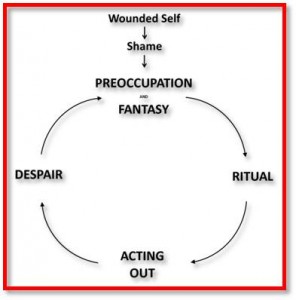“Specialized Experience in Core Issue Addiction Recovery”
written by Sue Moore, CPSAS, Forgiven Much Ministries 2012
The expanding impact of addiction on society is forcing a deeper look into what is behind these behaviors and the effectiveness of recovery methods and practices. In the US alone, population statistics indicate that 26%, 80 million people, 12 years and older abuse substances.1 Add to that 47% of Christians admit that pornography (only one of sixteen presentations of sexual addiction) is a major problem at home2 and we can clearly see that we are a culture reeling in the addictive condition. The question really is, “Are we ready to address what is driving our behaviors?”

Carnes – Cycle of Addiction
Based on decades of research, Dr. Patrick Carnes established the “Cycle of Addiction” which involves a sequence of stages beginning with Preoccupation or Fantasy, leading to Rituals, then Acting Out and Despair. Each repetition of the cycle intensifies the craving and neurochemical tolerance. In Carnes book, “Out of the Shadows,” he relays how this behavior begins with delusional thought processes that are rooted in the addict’s belief system. “Each person has a belief system that is the sum of the assumptions, judgments, and myths that he or she holds to be true. It contains potent family messages about a person’s value or worth, relationships, needs, and sexuality. Within it is a repertoire of what “options” – answers, solutions, methods, possibilities, ways of behaving – are open to each of us. In short, it is a model of the world.”
Since 2000, L.I.F.E. Recovery International has been at the forefront of sexual addiction recovery administering core issue methodology that addresses an addict’s underlying belief system. Through the course of ministry, L.I.F.E. can substantiate findings that sex addicts often present with 4-5 co-occurring addictions.3
Dr. Carnes, a sexual addiction expert, has also stated, “Seldom do these [persons] have only a sexual problem. Most (83%) have other addictive/compulsive disorders as well. For example, 41% have problems with alcohol or drugs, and 38% have an eating disorder. Other issues include gambling, financial disorders, and nicotine. Usually compulsive sexual behaviors are part of an intricate weave of behaviors to manage internal distress.”4
As I have worked with those in recovery I can affirm the validity of this statement and propose that the reverse is true too. Eating disorders, workaholism, codependency, body image issues, romance obsession, drugs and alcohol, internet and process addictions may have underlying sexual issues that are not being addressed by other recovery methods.
Although other Christian recovery models are established on the word of God and we agree that all of God’s word is profitable, the biblical foundation of the L.I.F.E. Recovery Guide principles simply direct participants toward the most effective work to reveal false belief systems, strongholds and proud arguments, better understood as core issues, that are raised up against the knowledge of God. L.I.F.E. Recovery Guides do this specifically and efficiently in a manner that promotes accelerated healing.
Understanding Core Issue Addiction Recovery
Discerning the best approach for addiction recovery is critical to success.
- The Disease/Behavioral Model believes that the abuse of the substance or behavior is the core issue.
- The Trauma/Core Issue Model believes that the deeper core issues drive the behaviors as a means of coping with pain.
Trauma, Intimacy and Growth
Post-Traumatic Stress Disorder: Common to all addictive/compulsive behaviors is a history of trauma and abuse. Sexually compulsive individuals have a history of sexual abuse (81%), physical abuse (72%), and emotional abuse (97%). Addictions and compulsions become a way to manage stress disordered affect and may include repeating the trauma compulsively.4
Intimacy Deficit: More than 87% of [addicts] come from disengaged families — a family environment in which family members are detached, uninvolved, or emotionally absent. All compulsive and addictive behaviors are signs of significant intimacy disorder and the inability to get needs met in healthy ways.4
The Dynamics of Post Traumatic Growth: PTG does not occur because of the core wounds, but rather occurs when the person goes beyond an adaptive response and learns how to struggle with the potential transformational possibility of the core issues. Terms like trauma, crisis, and stressful life events can be used interchangeably. “In developing literature on PTG, reports of growth experiences in the aftermath of stressful events far outnumber reports of psychiatric disorders.”5
The Process of Post Traumatic Growth: There are three critical elements that promote PTG for an individual that has experienced a traumatic life event.3
- Managing Distressing Emotions: A person learns to express all feelings relating to the injury including anger, anxiety, and sadness. In reality, this is grief work.
- Support and Disclosure: An individual practices disclosing honest feelings and thoughts about the core wounds with other supportive people. This must involve a system of social support.
- Cognitive Processing: The experience of core woundings lead to feelings of shame and distorted beliefs about God, self, and others. Cognitive restructuring is a function of helping a person “reframe” the experience in light of God’s truth. This includes helping the person discover how they are stronger today because of the core issue.
- We would add a fourth element – Forgiveness: In the process of religious and spiritual maturity, a person will learn how to embrace the process of forgiving the people and circumstances which caused the harm.3
L.I.F.E. Recovery Guides address the core wounds that drive the addictive behavior which the addict uses as a means to medicate pain and shame.
L.I.F.E. Recovery Groups offer participants a safe environment where they are no longer in isolation and are learning the healthy intimacy skills needed to express their feelings and process pain, all while in fellowship with others on the recovery journey.
Addiction is an intimacy disorder. People with an intimacy disorder are afraid to be known and to know other people. Unless the origins of core issues are uncovered and healing begins, even Christians offer external measures to control behaviors and switch addictions to a more socially acceptable method of coping. Now is the time to uncover and heal the core issues driving addiction both inside and outside the Church. We can Live In Freedom Everyday.
Citations:
1 NCASA (CASA Columbia) 2012
2 Focus on the Family
3Christopher J. Charleton, M.A., LCSW, a licensed clinical therapist, president of InterAct Counseling PLLC, author of “Relapse.”
4 Dr. Patrick Carnes http://enrichmentjournal.ag.org/200504/200504_022_internet.cfm
5 Dr. Mark Laaser, https://app.e2ma.net/app/view:CampaignPublic/id:30069.12909808166/rid:c055289c973e5238fde402bffba9703f
